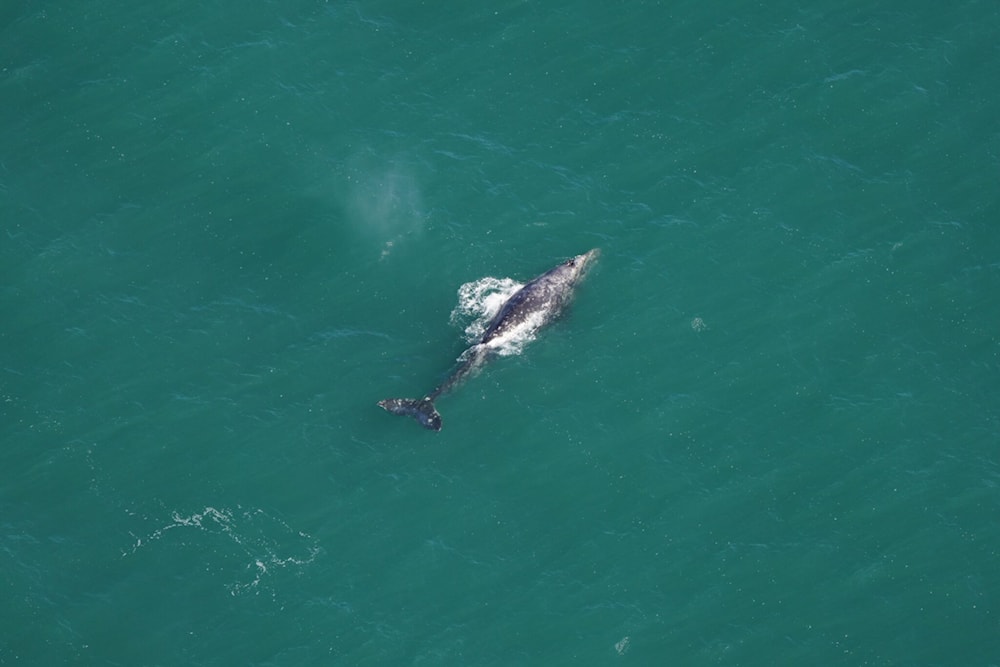200+ years later, gray whale spotted off the New England coast
On March 1, Aquarium scientists spotted a peculiar whale continuously diving and resurfacing to feed as they were flying 30 miles south of Nantucket.
-

A gray whale witnessed south of Nantucket on March 1, 2024. (New England Aquarium)
The United States' New England Aquarium aerial survey team spotted, in an extremely unique event, a gray whale off the New England coast last week, a species that has been extinct in the Atlantic for more than 200 years.
On March 1, Aquarium scientists spotted a peculiar whale constantly diving and resurfacing amid feeding as they were flying 30 miles south of Nantucket.
The aerial survey plane flew around the area in circles for 45 minutes, permitting observers to take additional photos. After the encounter, the observers studied the images and confirmed their suspicions, labeling the whale as a gray whale.
Researchers react
Associate research scientist in the Anderson Cabot Center for Ocean Life at the New England Aquarium Orla O’Brien stated “I didn’t want to say out loud what it was because it seemed crazy."
Research Technician Kate Laemmle, who was on the plane with O'Brien and was shown the whale pictures by the latter, said, “My brain was trying to process what I was seeing because this animal was something that should not really exist in these waters,” addingو “We were laughing because of how wild and exciting this was—to see an animal that disappeared from the Atlantic hundreds of years ago!”
Meet the Gray Whale
Gray whales are usually present in the North Pacific Ocean and are easily differentiated from other whale species by their lack of a dorsal fin, mottled grey and white skin, and dorsal hump followed by pronounced ridges.
They vanished from the Atlantic Ocean by the 18th century, however, in the last 15 years, there have been five spottings of gray whales in Atlantic and Mediterranean waters, with one off the coast of Florida in December 2023, which the scientists believe is the same one witnessed off New England this month.
The Washington Post, covering the sighting, recovered a colonial official’s writings from 1729 that described a “scrag whale” off the coast of Massachusets as the last time a grey whale was seen in that area, even though they are common off the coast of California.
Why has the whale suddenly emerged?
Scientists believe that this incident is related to climate change. The Northwest Passage, which links the Atlantic and Pacific through the Arctic Ocean in Canada, has frequently lacked any presence of ice in the summertime in recent years, partially because of increasing temperatures.
According to experts, sea ice usually restricts the presence of the gray whale species as they cannot cross it due to its thickness which in turn seals the Passage. However, as a result of the absence of ice at the moment, gray whales can possibly get through the Passage in the summer which was impossible in previous centuries.
O'Brien emphasized “This sighting highlights how important each survey is. While we expect to see humpback, right, and fin whales, the ocean is a dynamic ecosystem, and you never know what you’ll find,” adding “These sightings of gray whales in the Atlantic serve as a reminder of how quickly marine species respond to climate change, given the chance.”
Leigh Torres, a marine biologist from Oregon State U, speaking with the Post stated that she believes the most plausible reason why that gray whale was witnessed in the aerial survey was a "young juvenile who took a wrong turn.”
“I consider gray whales to be ‘risk takers,’ meaning they show up and feed in places that we often don’t expect or consider ‘normal,’” she stated then added that such behavior sometimes gives “good adaptation to changing conditions, like finding a new feeding area or food type,” she added.

 4 Min Read
4 Min Read








